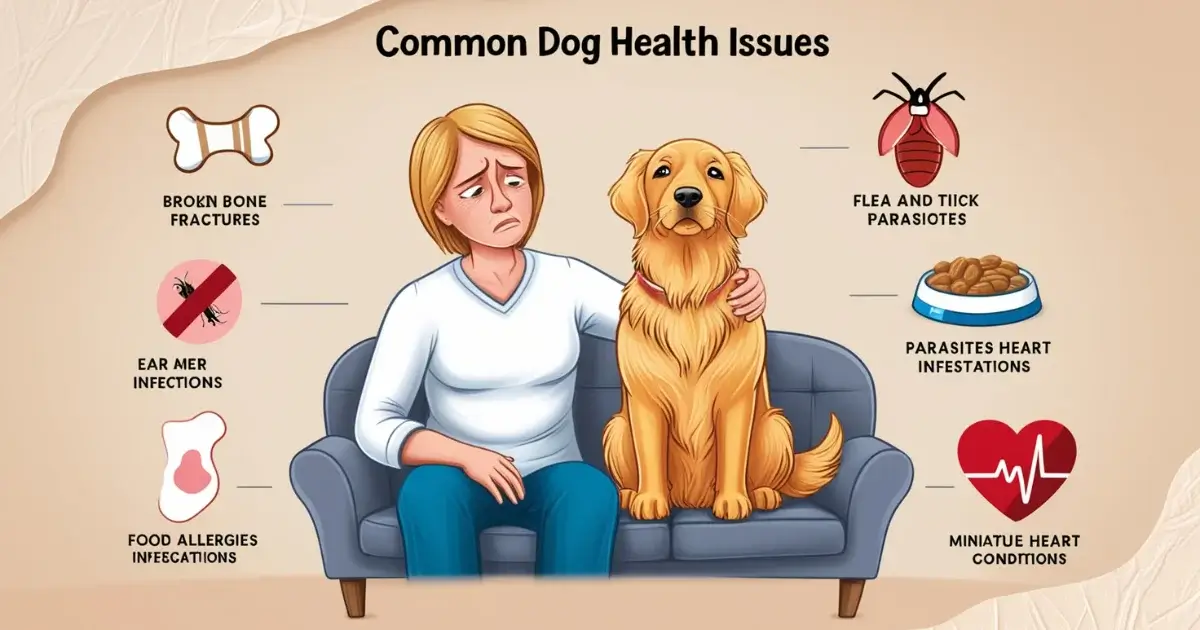Common Dog Health Issues: A Complete Guide to Canine Well-being
Dogs often face health challenges that need attention to ensure they live long and active lives. Recognizing and addressing common dog health issues helps keep them in the best shape possible. Here’s a detailed guide to understanding these issues and improving your dog’s quality of life.
Table of Contents
Understanding Dog Lifespan Statistics by Breed
What Influences a Dog’s Lifespan?
Several factors affect how long a dog lives. Breed size and genetics play a major role. Small breeds, like Dachshunds, generally live longer compared to larger breeds like Saint Bernards. A well-balanced diet, regular exercise, and proper veterinary care also extend a dog’s life expectancy.

Life Expectancy Trends for Popular Breeds
Dogs are living longer than before due to better care. Below are the typical lifespans of some popular breeds:
- Dachshunds: 12–16 years
- Labrador Retrievers: 10–14 years
- Poodles: 12–15 years
Being aware of dog lifespan statistics by breed helps owners make informed health decisions to promote longevity.
Canine Diseases Prevalence: Symptoms and Prevention
Most Common Diseases in Dogs
Dogs often experience certain diseases throughout their lives, such as:
- Arthritis: This causes joint stiffness and pain, especially in older dogs.
- Obesity: Overfeeding and lack of exercise increase the risk of diabetes and heart disease.
- Skin Allergies: Dogs frequently suffer from itchy skin, often caused by environmental or food allergens.
Understanding canine diseases prevalence is vital to early detection and treatment.
Recognizing Sick Dog Symptoms
Early identification of symptoms ensures timely medical care. Watch for signs such as:
- Appetite loss or energy reduction
- Persistent vomiting, diarrhea, or coughing
- Unusual urination patterns
A proactive approach helps address health issues before they worsen.
Prevention Tips for Common Canine Illnesses
Regular preventive care is essential. Key measures include:
- Annual vet checkups to catch problems early
- Vaccinations to protect against life-threatening diseases
- Regular grooming to maintain skin health and detect abnormalities
Preventive actions reduce the risk of common dog health issues significantly.
Health Concerns by Size and Breed
Large Dog Breeds
Large dogs, such as German Shepherds and Great Danes, often experience hip dysplasia. This condition affects their mobility and requires medical attention. Bloat is another severe issue for large breeds, causing dangerous stomach swelling.
Small Dog Breeds
Smaller dogs face different challenges. Tracheal collapse, a narrowing of the windpipe, is common in breeds like Yorkshire Terriers. Heart problems, such as mitral valve disease, are frequently seen in Cavalier King Charles Spaniels.
Breed-Specific Genetic Conditions
Some breeds inherit unique health risks. Bulldogs often struggle with respiratory conditions due to their short muzzles. Beagles may develop epilepsy, while Golden Retrievers are prone to certain cancers. Early screening helps manage these issues effectively.
Pet Health Care Statistics Every Dog Owner Should Know
Medical Expenses for Dogs
Caring for a dog involves ongoing costs. Routine veterinary care, including vaccinations and wellness exams, typically costs between $200 and $500 annually. Emergency treatments or surgeries can exceed $2,000.
Role of Pet Insurance in Reducing Costs
Pet insurance provides financial relief for medical emergencies. Many policies cover diagnostic tests, treatments, and routine care. Statistics show insured dogs receive faster medical intervention, improving recovery rates.
Vaccination and Wellness Check Trends
Vaccination rates are rising, reducing the spread of diseases like parvovirus and distemper. Regular wellness checks ensure early detection of issues, lowering treatment costs and enhancing pet health.
Average Dog Medical Expenses: Budgeting for Pet Health
Routine Costs
Routine care includes annual exams, vaccinations, and grooming. Here’s a breakdown of typical costs:
| Expense Type | Average Cost |
| Annual Checkups | $50–$250 |
| Vaccinations | $75–$100 |
| Grooming | $30–$90 per session |
These regular expenses are crucial for maintaining your dog’s health.

Emergency Expenses
Unexpected treatments, such as surgery or long-term medication, can be costly. Treatments for conditions like bloat or fractures often exceed $1,500. Planning for emergencies helps reduce financial stress.
How to Save on Veterinary Costs
Cost-saving tips include:
- Scheduling regular vet visits for preventive care
- Investing in pet insurance to cover major expenses
- Grooming your dog at home to lower routine costs
Planning ahead reduces the burden of average dog medical expenses.
How to Keep Dogs Happy and Healthy
Balanced Diet and Exercise
A healthy diet supports your dog’s energy and immune system. Puppies need nutrient-dense food, while senior dogs benefit from low-calorie options. Exercise, such as daily walks or active play, strengthens muscles and improves mental health.
Grooming and Dental Hygiene
Grooming keeps your dog comfortable and prevents skin infections. Regular dental care is equally important, as periodontal disease affects most dogs by age three. Brushing their teeth a few times a week helps maintain oral health.
Recognizing and Addressing Behavioral Changes
Behavioral changes, like increased anxiety or lethargy, can signal health problems. Addressing these changes promptly ensures your dog’s physical and emotional well-being.
Conclusion
Addressing common dog health issues requires a proactive and informed approach. Regular checkups, preventive care, and a healthy lifestyle improve a dog’s quality of life. With proper attention to their needs, you can ensure your dog enjoys a happy, healthy life by your side.
FAQs
How do different dog breeds compare in terms of lifespan?
Smaller breeds, like Dachshunds, typically live 12–16 years, while larger breeds, such as Great Danes, average 7–10 years. Knowing dog lifespan statistics by breed helps tailor care and lifestyle to maximize longevity.
What is the average cost of emergency medical care for dogs?
Emergency treatments often cost over $1,500, depending on the severity of the issue. Planning for average dog medical expenses with pet insurance or savings can reduce financial stress during emergencies.
How can pet owners reduce the risk of common diseases in dogs?
Preventive measures include regular vet visits, vaccinations, and a healthy diet. Understanding pet health care statistics shows that early intervention is key to preventing conditions like obesity and arthritis.
Why is grooming important for a dog’s overall health?
Grooming prevents skin infections, keeps coats clean, and helps spot issues early. Regular dental care also reduces the risk of oral diseases, a common concern highlighted in canine diseases prevalence.







